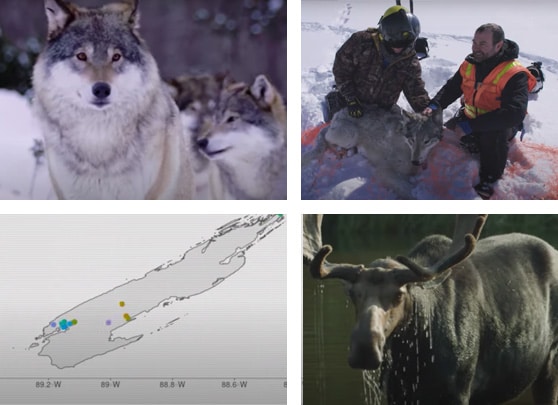A new 40-minute documentary features the wolves and moose of Isle Royale National Park. It traces the island’s history, and the 60-year study conducted there on the relationship between the predator and its preferred prey. The film and accompanying curriculum are intended to help educators teach K-12 students about the unique ecosystem found on the Lake Superior archipelago.
“Return of the Wolves: Lessons from the Wilderness” includes footage of capturing wolves on the mainland and releasing them on Isle Royale, as part of a reintroduction program initiated by the National Park Service in 2018. The documentary and curriculum were produced by the National Parks of Lake Superior Foundation, based in St. Paul, MN.
“Knowing how wolves fascinate people, and that teachers are dealing with constantly changing demands, we developed lesson plans for all student age groups,” said Tom Irvine, the group’s executive director.
In addition to unique footage of capturing and fitting radio collars on wolves and moose, the film also includes the voices of university researchers, tribal biologists, veterinarians, and Park Service experts involved in wolf relocation.

The curriculum that accompany the film includes lesson plans and other materials for students ranging from kindergarten through 12th grade. Activities include discussions, scientific experiments, and art projects. The curriculum is designed to meet several educational standards and is suitable for traditional and homeschool students.
“It’s one thing to read a quick story because that is what you have time for … but through these lesson plans you can delve into what it really means and what should I be trying to figure out,” retired Isle Royale superintendent Phyllis Green, who was a driving force behind the film, told the Star Tribune.
The film and curriculum delve into the complicated and challenging questions about ecosystem health, wilderness protection, global environmental changes, and human intervention. While both moose and wolves are native to Isle Royale and the surrounding region, when wolf numbers on the island plummeted early last decade, the moose population exploded, threatening to devastate the National Park’s vegetation.
“Students participating in the educational lessons will have a chance to tap into the biology and population dynamics of the moose and wolves on Isle Royale National Park,” the foundation said.
The film does not shy away from the difficulties that have faced the reintroduction. Park Service staff shared the challenging decisions and logistics of the effort, while researchers explain the history and hopes of studying the predator-prey relationship.
“After the Park decided to restore the wolves to function as the top predator on an island populated with a large prey base of more than 1,800 moose, the Foundation started to document the difficulties in restoring the population, and the science and activities related to how ecosystems function and the role of a dynamic predator in impacting a large prey, and its impacts on the ecosystem,” the foundation said.
The film was the result of a partnership involving National Park Service staff, the International Wolf Center in Ely, Michigan Technological University, State University of New York College of Environmental Science and Forestry, and the Cane-Bridge Foundation of Bogota, Columbia.
The foundation reports that interest has been high, with numerous downloads of the materials. To expand its reach, a Spanish-language version of the film and curriculum, funded by the Cane-Bridge Foundation, will be released on March 7.
More information:
- Return of the Wolves: Lessons from the Wilderness – National Parks of Lake Superior Foundation
- Lessons from the Wilderness Curriculum
- Isle Royale wolf relocation inspires documentary, coursework for students – Star Tribune

